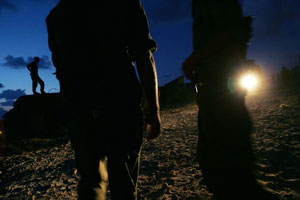It was a 13-year-old settler boy from a ramshackle collection of trailer homes along the sea that may have saved me.
For five months I have been living in the Jewish enclave of Gush Katif, getting to know the human side of a community that feels it is demonized both in Israel and abroad for stubbornly refusing to leave land they claimed as their Biblical birthright but that Palestinians see as part of their future state.
 |
An Israeli settler boy walks alongside an Israeli Markava tank parked inside the Israeli settlement of Katif as part of preparations for an upcoming carnival to be held there in honor of Israeli Independence Day, 10 May 2005. AFP PHOTO/DAVID FURST |
Now stones were raining down around me as I photographed clashes that resulted in a Palestinian boy nearly being lynched by a group of settler youth. But when the pack of kids began pulling at my cameras, I realized I was facing a more immediate threat than the hurtling projectiles.
Amid the chaos I suddenly heard the words, "He's with me, he's OK. We trust him!" from the boy with sidelocks that stretched down to his chin. I had come to know his family over the past months. I even had dinner at their home the week before. With the boy's words, the crowd backed off. When I lifted my camera again I saw they had returned their attention to the criss-cross of stone throwing with Palestinian boys across the street. Once again I had full, close-up access to shoot the scene.
 |
A Jewish settler pauses during prayer in a makeshift synagogue in the abandoned Israeli Palm Beach Hotel, renamed by settlers the "Maoz Hayam," on the coastline of the southern Gaza Strip Gush Katif settlement bloc area, 28 June 2005. Dozens of extreme right-wing settlers from around the country have moved into the hotel in an attempt to oppose Israeli Prime Minister Ariel Sharon's disengagement plan. AFP PHOTO/DAVID FURST |
But the next day, when an Israeli newspaper ran my images on the front page of Jewish settler youth, stones in hand, appearing menacing and cruel, I was suddenly assailed by the people I had come to know as neighbors. They cursed my photos as "biased" and I came home to a dozen near identical phone messages: "We let you live among us, you photograph us with our permission and now you have betrayed us."
After living in a small stucco house on the sand-swept edge of Neve Dekalim, the largest of the 21 Jewish settlements in the Gaza Strip I have become both chronicler of the news and part of the landscape myself. The settlers know me by name, invite me for Sabbath dinner, wave hello. But I feel the contradiction of knowing, and in many cases liking, the people here, and yet feeling at odds with the ideology they hold dear.
I wake up every morning to see the sun rise over the settlement's green lawns and trimmed rose garden suburbia. I notice the high concrete wall and watchtowers that surround the settlement and cut it off from the sprawling Palestinian refugee camp that is its neighbor. I am aware that I have been given a tremendous opportunity: an extended assignment on the front rows of history to witness another potential turning point in the troubled relationship between Israel and the Palestinians.
 |
Israeli soldiers stand as a tank maneuvers into position at a staging area set up adjacent to the southern Gaza Strip Gush Katif settlement of Ganei Tal, 16 July 2005. AFP PHOTO/DAVID FURST |
Experiencing the every day, I now see Gush Katif less as a caricature and more as a living, breathing entity. I watch the seeming normalcy of parents pushing their toddlers on swings in the park and families shopping at the corner store. I wrestle with how to document a community that refuses to give up, a place where people continue to water lawns and run greenhouses when evacuation is just weeks away. I confront also the daily struggle within myself to describe their reality, which is at the same time so foreign to me and so abnormal. How, I ask myself, will I convey that kind of quiet dignity and defiance laced with extremism in my photographs?
But every day I pick up my camera and look for the next image, knowing that very soon what I am photographing will no longer exist except in pictures.
David Furst is from Englewood, New Jersey. After graduating from Boston University in 2002 with a degree in philosophy, he commenced a career in photojournalism by freelancing in Manhattan, New York. He has since covered stories in Iraq, Israel, the Palestinian Territories, Egypt, Jordan, and is currently based in the Gaza Strip for Agence France-Presse.






